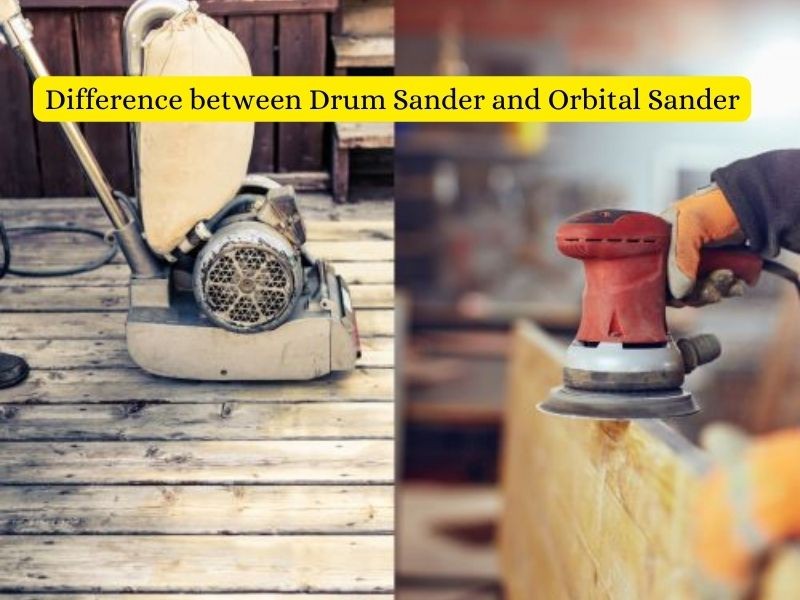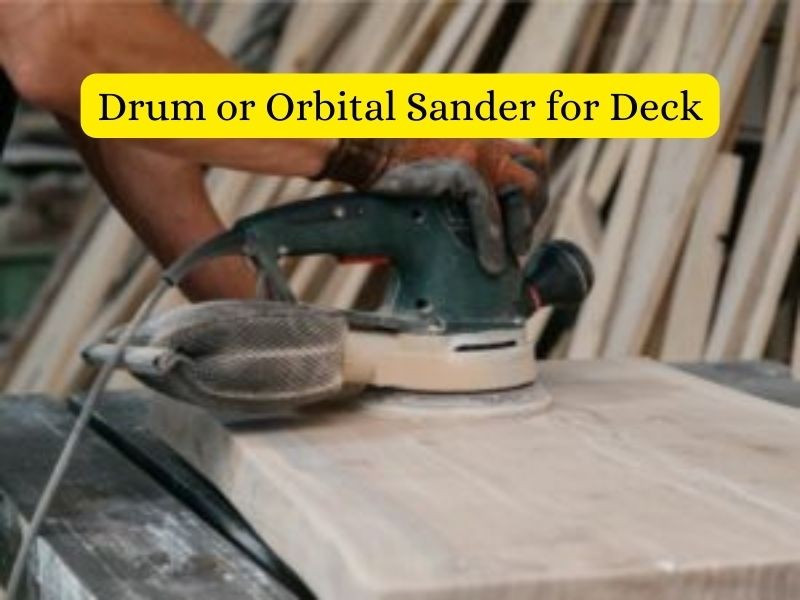If you are in the market for a new sander to help you refinish your deck, you might be wondering whether a drum sander or an orbital sander is the right choice for your needs. In order to assist you in making an informed choice, we will be taking a closer look at the details of each type of sander.
Difference between Drum Sander and Orbital Sander:

For woodworking, there are basically two types of sanders that people use:
- Drum Sanders
- Orbital Sanders
In order to understand the difference between the two types of sanders, here’s a quick overview:
Drum sander:
Drum sanders have a greater power than other types of sanders. They are better suited for sanding tougher materials, as they can work faster and with less effort on them. There is no doubt that drum sanders are more suitable for larger projects. This makes them a perfect choice for sanding large pieces of wood, because of their large surface area.
Orbital Sander:
It is true that orbital sanders are very versatile than other sanders. Considering their versatility, they can be used for a variety of tasks, such as sanding curves and corners. The orbital sanders are convenient to use because they are more controllable. Because of their smaller size, they are easily portable, and their orbital motion prevents them from leaving behind deep scratches on your floor.
Drum Sander or Orbital Sander for Deck, Which one is right for the Project:

If you are looking to refinish a deck, there are a few things you need to consider before you start sanding. One of the most important decisions you will make is whether to use a drum or orbital sander for deck.
There are a few things you need to consider before choosing a drum or orbital sander for deck:
1. Type of Deck:
In order to sand composite decks made of man-made materials, you should use an orbital sander. These materials are softer than natural wood, so a drum sander could damage them. But if you are working with a wooden deck, either type of sander will work.
2. Condition of Deck:
If your deck is in good condition with only minor imperfections, an orbital sander will be sufficient. Drum sanders will be needed to remove damaged material from a deck that has deep scratches or gouges.
3. Personal Preferences:
Some people prefer the orbital sander because it’s easier to control and produces less dust. Others prefer the drum sander because it’s more powerful and can sand large areas quickly. Ultimately, the decision comes down to personal preference.
4. Area of the deck:
Drum sanders are better suited for large decks because they can cover larger areas faster. The orbital sander is perfect for sanding small areas.
5. The type of wood:
Depending on the type of wood you are working with, you will need to select a sander that can handle it.
6. The budget:
The price of the sander is a important factor to consider, as more powerful sanders can be quite expensive. An investment in a sander might be worthwhile if you are going to use it frequently.
Now that you know what to look for in a drum sander or orbital sander, you can start shopping around for the perfect tool for your needs. With a little bit of research, you will be sure to find the perfect sander for your deck sanding needs.
Pros of Drum Sander Over Orbital Sander:
- The drum sander is better at removing deep scratches and stains than the orbital sander.
- In comparison with orbital sanders, drum sanders can remove more material in less time.
- For sanding very hardwoods, such as maple or oak, drum sanders are better because they remove material more quickly.
- It is also better to use a drum sander for rough surfaces, such as planed wood that is not yet smoothed after planing.
Pros of Orbital Sander Over Drum Sander:
- An orbital sander is easier to control than a drum sander. This makes it possible to avoid sanding too much material off of your workpiece.
- The orbital sander leaves a smoother finish than the drum sander. This is because the orbital sander moves in a small, circular motion, while the drum sander moves in a straight line. This causes the sandpaper to wear out more evenly, resulting in a smoother finish.
- Sanding with an orbital sander is easier on the hands than with a drum sander. This makes it less likely that you will experience fatigue or pain in your hands after using the orbital sander for an extended period of time.
- The orbital sander is less likely to damage your workpiece than the drum sander. As a result, it is less likely that you will accidentally sand too much material off your project.
- Compared to drum sanders, orbital sanders are significantly quieter. When using the orbital sander, you are less likely to disturb your neighbors or family members.
FAQs:
Q: What does a drum sander do?
A: A drum sander is a power tool that uses a rotating abrasive sanding drum to remove wood or other materials from a workpiece.
Q: How do I choose the right sander for my project?
A: Consider the type of material you will be sanding and the size of the surface area. Also, think about whether you need a sander with a dust-collection feature. It is typically best to use drum sanders for large projects, while orbital sanders can be used both for small and large projects.
Q: How do I use a drum sander?
A: Follow these steps:
- Before using a drum sander, read the manufacturer’s instructions carefully.
- Make sure the sander is properly secured to a work surface and that the sanding drum is properly installed.
- Start the sander and slowly lower the sanding drum onto the surface of the material you are sanding.
- Move the sander forward and backward in a smooth, even motion.
- To avoid damaging the material, do not apply too much pressure.
Q: What are some safety tips for using drum sanders?
A: Use drum sanders safely by following these tips:
- Always wear proper safety gear, including eye protection and a dust mask, when using sanders.
- Be sure to keep the work area well ventilated to avoid breathing in dust particles.
- Avoid using sanders in wet or humid conditions, as this can increase the risk of electrocution.
- Never leave a sander unattended while it is running.
- Turn off the power and unplug the sander when not in use.
Q: Can we use drum sander on wet surfaces?
A: No, you should not use a drum sander on wet surfaces as this can increase the risk of electrocution. Always make sure the surface you are sanding is dry before beginning your project.
Q: Will a drum sander flatten a board?
A: Yes, a drum sander can be used to flatten a board. Be sure to use the correct grit sandpaper for your project and move the sander in a smooth, even motion to avoid damaging the material.
Q: What are some things I should avoid doing with a drum sander?
A: Some things you should avoid doing with a drum sander include sanding wet or humid surfaces, sanding too aggressively, and leaving the sander unattended while it is running. To avoid damaging the material or injuring yourself, always read the instructions carefully before using the sander.
Q: How much wood does a drum sander remove?
A: It depends on the grit of sandpaper you’re using and how aggressively you’re sanding. Generally, each pass should remove no more than 1/32 of an inch of material.
Q: How often should I change the sandpaper on my drum sander?
A: You should change the sandpaper on your drum sander when it becomes clogged or worn. Depending on the type of project you are working on, you may need to change the sandpaper more frequently.
